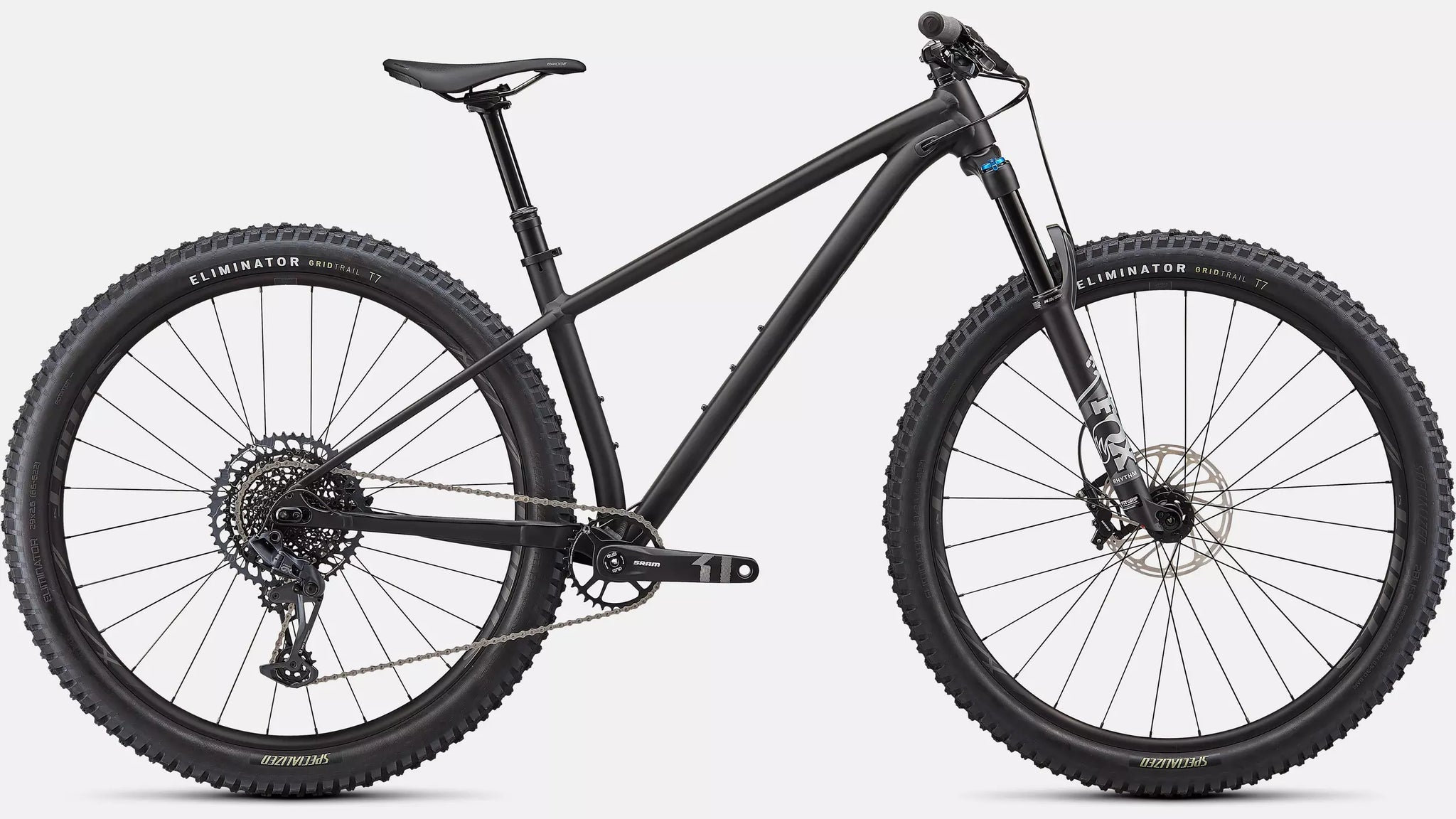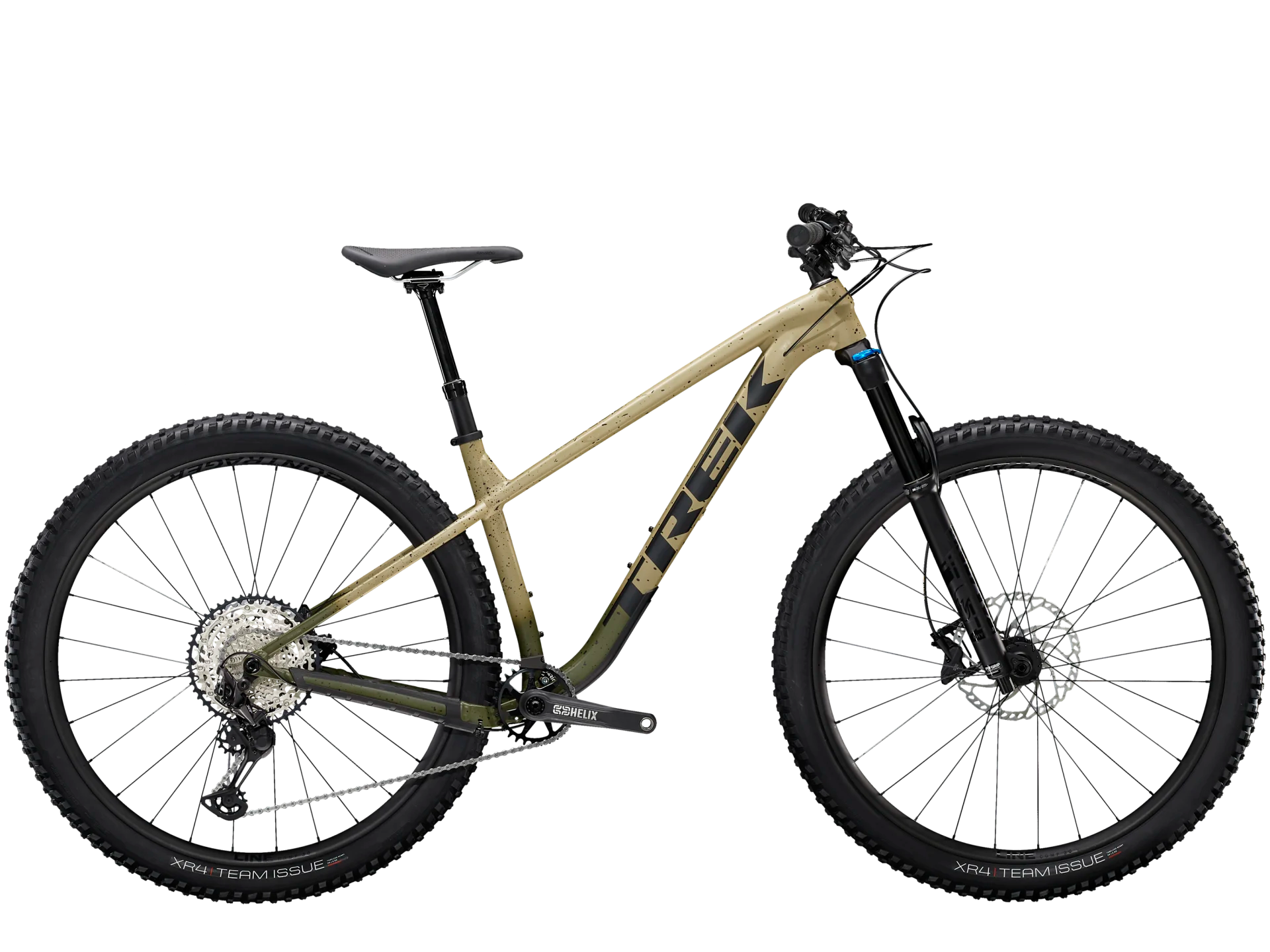What’s the best mountain bike to get if you’re on a budget? The answer is an affordable and versatile trail hardtail. Trail hardtails are simple (there’s no rear suspension) so they’re cheaper and easier to own and maintain. But with relaxed geometry and a longer travel fork, they can handle a wide range of terrain from fast flow trails to steep and gnarly downhill tracks.
The two most popular models in the trail hardtail category are the Specialized Fuse Expert 29 and the Trek Roscoe 9. They’re best sellers and they come with decent mid-range components so they won’t need any upgrades. But how do they stack up against one another? We compare these two do-it-all hardtails to find out.
[button]Shop Mountain Bikes[/button]
1. Specialized Fuse vs. Trek Roscoe: Overview
|
Specialized Fuse Expert 29 |
Trek Roscoe 9 |
|
|
Frame Material |
Aluminum |
Aluminum |
|
Wheelsize |
29" |
29” |
|
Fork |
Fox Rhythm 34, 130mm |
Fox Rhythm 36, 140mm |
|
Drivetrain |
SRAM GX Eagle |
Shimano SLX/XT |
|
Brakes |
SRAM G2 |
Shimano M6000 4-piston |
|
Wheels |
Specialized Alloy |
Bontrager Line Comp 30 |
|
Dropper |
TransX |
TransX |
|
Claimed Weight |
29.9 lbs (Med) |
28.95 lbs (Med) |
|
Price |
$2,900 |
$2,499 |
Both bikes use aluminum frames with threaded bottom brackets, internal cable routing, two bottle cage mounts, and 29” wheels. Both weigh right around 30 pounds, which is fairly standard for entry- to mid-level aluminum hardtails.
 The 2023 Specialized Fuse Expert 29 comes with a SRAM GX drivetrain.
The 2023 Specialized Fuse Expert 29 comes with a SRAM GX drivetrain.
 The 2023 Trek Roscoe 9 uses Shimano SLX and XT drivetrain.
The 2023 Trek Roscoe 9 uses Shimano SLX and XT drivetrain.
Both use TransX dropper seatposts. Other than the drivetrains, the biggest difference between the two bikes is in the forks. The Fuse comes with a 130mm Fox Rhythm 34 while the Roscoe uses a 140mm Fox Rhythm 36. The Fox 34 is lighter because it has thinner 34mm stanchions compared to the Fox 36 which uses 36mm stanchions. On the flip side, the Fox 36 is a bit stiffer and has more travel than the Fox 34, which keeps it a bit more plush feeling and composed on rough terrain. The Fox 36 caters more toward aggressive downhill riding while the Fox 34 is a bit more balanced for all-around trail riding.
One other feature worth noting is the sliding rear dropouts on the Fuse. This gives riders the option to adjust the chainstay length or set the frame up as a single speed.
2. Specialized Fuse Expert 29 vs. Trek Roscoe 9: Component Comparison
- Frame: Both frames are nearly identical in terms of construction and quality. I prefer the adjustable rear dropouts of the Fuse, however, because it gives riders more adjustability, plus additional options for fixing backcountry mechanicals or trying a future singlespeed build. Winner: Fuse
- Fork: Both use Fox Rhythm forks with the basic Grip damper. I tend to prefer the stiffer Fox 36 chassis because I ride more rough and technical downhills. Winner: Roscoe
- Drivetrain: SRAM GX vs. Shimano SLX/XT are both super solid and reliable. I’m a SRAM user, and I like that the Fuse has a 52t granny gear (vs. 51t) and it doesn’t use a third-party crankset (the Roscoe uses an e*thirteen crank). Winner: Fuse
- Brakes: Both bikes have 4-piston brakes for extra stopping power. I personally prefer the feel of SRAM brakes to Shimano. Winner: Fuse
- Wheels: Both bikes use entry-level alloy wheels with 29mm internal rim widths and basic hubs. There’s really nothing to choose between these wheels, but I like that the Bontragers aren’t generic and at least have a model name… Winner: Roscoe
- Dropper: Both bikes use basic TransX droppers with similar travel for the various frame sizes. I’m going to give this to the Roscoe though because it uses the more common 31.6mm size versus the oversized 34.9mm dropper on the Fuse. It will be easier to replace or upgrade in the future. Winner: Roscoe
- Weight: With the stock build, the Roscoe is about a pound lighter. Winner: Roscoe
- Price: The Roscoe retails for $400 less. Winner: Roscoe
Final Score
- Fuse Expert 29: 3
- Roscoe 9: 5
It looks like the Roscoe beats out the Fuse by a couple of points, but keep in mind that these points are mostly based on my personal tastes and are pretty subjective.
 SRAM fans might prefer the Fuse and Shimano fans might prefer the Roscoe. If you want to upgrade your bike to shed weight, the Fuse has more potential to get lighter because it has a lighter Fox 34 fork. If you’re more interested in pushing it on gnarlier downhills, the Fox 36 on the Roscoe is a better starting point.
SRAM fans might prefer the Fuse and Shimano fans might prefer the Roscoe. If you want to upgrade your bike to shed weight, the Fuse has more potential to get lighter because it has a lighter Fox 34 fork. If you’re more interested in pushing it on gnarlier downhills, the Fox 36 on the Roscoe is a better starting point.
Some features may also be more important to some riders than others. For example, the sliding rear dropout is the standout feature of the Fuse to me, and it’s the main reason I’d pick the Fuse, but many other riders likely won’t care about it.
3. Specialized Fuse vs. Trek Roscoe: Geometry Comparison
|
Specialized Fuse Expert 29 |
Trek Roscoe 9 |
|
|
Stack |
625mm (Med) |
635mm (Med) |
|
Reach |
440mm |
440mm |
|
Head Angle |
66.5° |
65° |
|
Seat Angle |
74° |
74.7° |
|
Toptube |
619mm |
614mm |
|
Seattube |
410mm |
420mm |
|
Chainstay |
420-435mm |
430mm |
|
Wheelbase |
1162mm |
1181mm |
|
BB Drop |
60mm |
61mm |
|
Standover |
750mm |
748mm |
The Fuse and Roscoe use very similar geometry. The biggest difference between the two frames is the head angle. The Roscoe’s 65-degree head angle is 1.5 degrees slacker than the Fuse (which also gives the Roscoe a ~20mm longer wheelbase). What does this mean? In the most basic terms, the Roscoe will feel more stable while the Fuse will feel more agile. Both bikes can handle a very wide range of terrain, but if you’re regularly riding steep and fast downhill trails, the slacker Roscoe will feel a bit more confidence-inspiring. The Fuse, on the other, will feel less sluggish on climbs, and more lively on flat or rolling trails.
Both bikes have decently steep seat angles to put riders in a good position over the cranks on steep climbs, but the Roscoe’s seat angle is slightly steeper, which some riders might prefer (though I honestly don’t think that 0.7 degrees will make that big of a difference).
The other notable difference is in the stack height. In every size, the Fuse has 5-10mm less stack height. This can be important to riders who want to run a lower bar height for XC riding.
Note that the Fuse has a range for chainstay length because of the sliding rear dropouts. It can be adjusted to be both shorter (more agile) and longer (more stable) than the Roscoe.
Finally, it’s worth noting that the Roscoe is also available in an additional M/L size. This could be good for riders who feel like they are between the medium and large sizes.
4. Concluding Thoughts
 Both the Specialized Fuse Expert 29 and the Trek Roscoe 9 are solid and affordable trail hardtails that will offer a lot to both beginner and experienced mountain bikers. Beyond price, the two biggest factors riders should consider when choosing between these two bikes are the forks and the head angles — that’s where these two bikes differ the most.
Both the Specialized Fuse Expert 29 and the Trek Roscoe 9 are solid and affordable trail hardtails that will offer a lot to both beginner and experienced mountain bikers. Beyond price, the two biggest factors riders should consider when choosing between these two bikes are the forks and the head angles — that’s where these two bikes differ the most.
With a lighter Fox 34 fork and slightly steeper head angle, the Fuse should appeal more to riders who lean more toward the XC side of the riding spectrum. For riders more interested in the enduro and downhill side of the spectrum, the bigger Fox 36 fork and slacker head angle of the Roscoe will be more appealing.
As for value, the Fuse Expert 29 and Roscoe 9 have very comparable specs, so the Roscoe is the better value with a retail price that is $400 less.
What would I pick? Personally, I’d choose the Fuse. As I’ve already mentioned, I’m a SRAM fan and I like having a sliding rear dropout so I can convert the bike to a singlespeed someday in the future. What would you choose?
[button]Shop Mountain Bikes[/button]

























